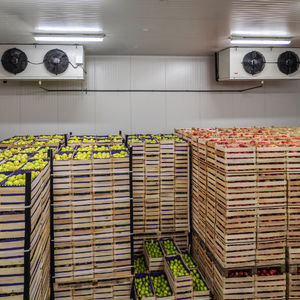Ozone extends food shelf life
Common Applications for Ozone use in Food Storage:
-
Potato
- Onion Storage
- Citrus Fruit Storage
- Vegetable Storage
- Aged Ham Storage
- Cool Meat Storage
- Preservation of Fish and Seafood
- General Cold Storage Facilities
Methods of Ozone Application:
- Gaseous ozone can be distributed throughout a cold storage facility at low levels
- Ozone-sterilized ice is used to pack fresh fish and seafood to prolong freshness
- Ozone gas is used in meat coolers to inhibit microbiological growth and extend shelf life
- Ozone is dissolved into water to wash fruits and vegetables to remove mold and bacteria
- Low levels of gaseous ozone can be used in containers to prolong shelf life upon delivery
- Dissolved ozone is used to wash meat and poultry to remove bacteria and extend refrigerated shelf life
Benefits of Ozone Use in Cold Storage:
- Extend shelf-life of the produce within the cold storage facility
- Air-borne microbiological control
- Low ozone levels (<.3 ppm) will inhibit microbiological growth in the air
- High ozone levels can be used for disinfection when room is empty
Surface Sanitation can be Maintained
- By inhibiting microbiological growth, pathogens on the surface of produce, containers and walls will be kept to a minimum
- Eliminate mold growth from cold storage area
Odor Control
- Maintain an odor-free cold storage area
- Keep odors from cross contaminating between products
- Ethylene removal
Extension of Storage Life With Ozone
| Food | Extension | Storage Conditions |
|---|---|---|
| Fish | 50-80% | Ozone sterilized ice |
| Salmon | 50% | Ozone sterilized ice |
| Jack Mackeral and Shimaaji | 1.2-1.6 days | Soak in 30% NaCl cont. 0.6 mg/L O 3 30-60 mins every 2 days |
| Beef (frozen) | 30-40% | 0.4% C; 85-90% RH; 10-20 mg/m 3 O3, provided microbial count is below 103/cm2 |
| Poultry | 2.4 days | Soak in ice water while passing in O 3 (3.88 mg/L) 20 min. |
| Bananas | substantial | A few ppm O 3 @ 12°C, if fruit is not within a few days of its period of rapid ripening. |
| Strawberries, Raspberries, Currants, Grapes | 100% | 2-3 ppm O 3, continuously or several hours each day |
| Apples | several | 1.95 cm 3 O3/m3 |
| Potatoes | 6 months | 3 mg/L O 3; 6-14°C; 93-97% RH |
| Eggs | 8 months | 0.6 ppm O 3; 31°F; 90% RH |
| Cheeses | 63 days | 0.2-0.3 ppm O 3 |
* Source: Review of the Applications of Ozone for Increasing Storage Times of Perishable Foods, Ozone: Science and Engineering, Vol. 4, pp. 147-163, 1982, Pergamon Press Ltd.
Ozone is Allowed for Direct Contact with Food
- August 13, 1999 - FDA issues 21CFR Part 173.368 giving ozone GRAS approval for use on all meat and poultry products.
- December 23, 1999 - FSIS published final rule approving the use of ozone in meat and poultry products.
- December 17, 2002 - USDA issues FSIS Directive 7120.1 naming ozone a Safe and Suitable Ingredient Used in the Production of Meat and Poultry Products

